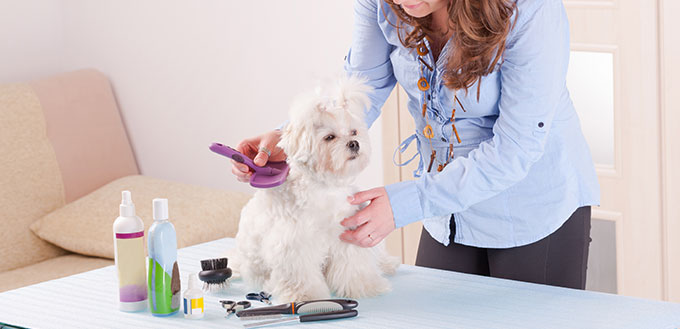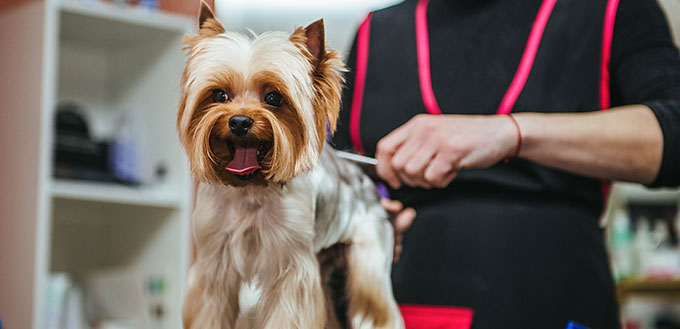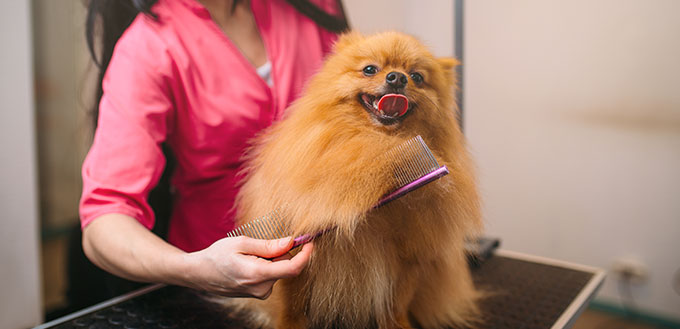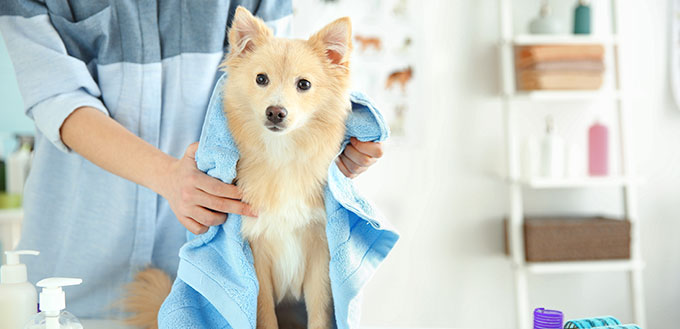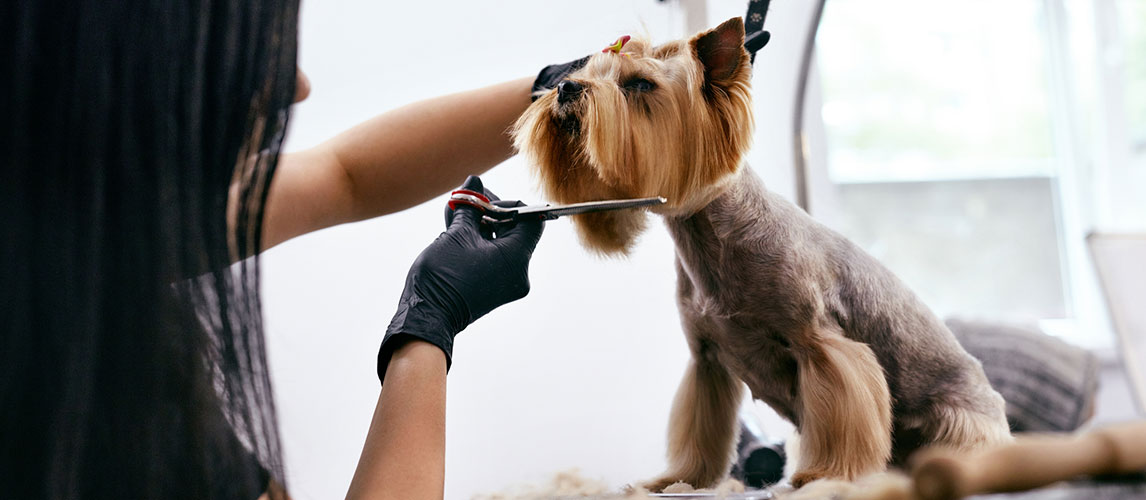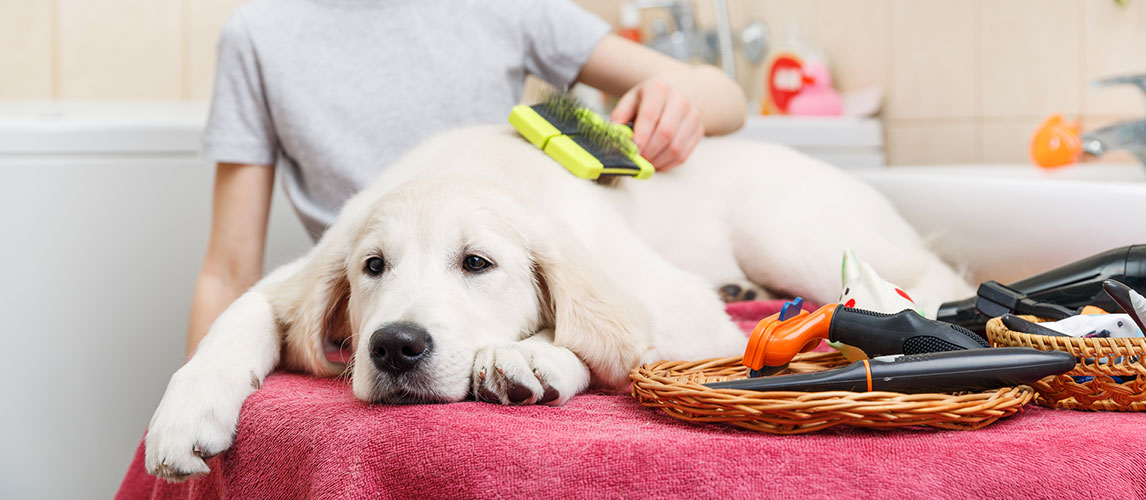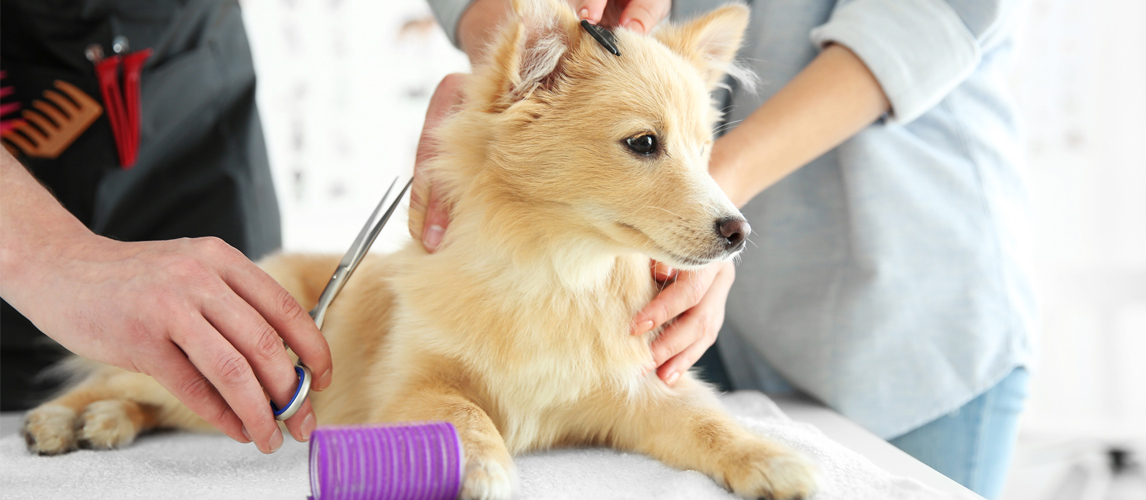Good grooming is essential to your dog’s wellbeing and should be part of your everyday pet care routine. And, even if you do use a dog groomer, it’s always a good idea to know the basics so you can continue to take care of him at home.
But not all dogs relish the idea of a bath, brush or nail trimming, so acquiring the right skills and tools for the job will make it easier for everyone concerned. We can help you brush up on your dog grooming techniques with our guide – How to Groom a Dog at Home: 10 Professional Dog Grooming Tips.
Invest in the Right Tools
Having the right grooming tools is the best place to start, and it doesn’t mean spending a fortune. To give your pooch the best dog grooming experience in the comfort of his own home, you’ll need:
- A quality brush or comb: Your dog’s coat type and hair length will dictate which type of dog brush you should opt for, from simple rubber brushes for short coats to metal combs that are effective in reaching loose fur. You may also want to add a flea comb to your collection, especially if your pooch socializes with other dogs.
- Nail clippers: Long nails are not good for your dog and can cause discomfort. As part of your dog’s grooming routine, they’ll need their nails regularly clipped, whether that’s with straightforward nail clippers or the type that grinds down the nail.
- Pet scissors: Your dog groomer may well do the full fur clip, but a pair of pet-safe scissors also means you can keep longer-haired breeds such as Shih Tzus neat between appointments. Even short-haired dogs may still need a trim, especially on their foot hair.
- Dog shampoo: It’s essential that you only ever use shampoos formulated for your dog as human shampoo won’t cut it. Look for dog shampoo products that are suited to your pet’s coat and is easy to rinse out. Also be aware of any skin problems your dog may have, particularly with breeds such as bulldogs and Shar Peis, to ensure the dog or puppy shampoo is hydrogen peroxide free and gentle enough to prevent irritation.
- Bath towels: Bathtime can be a wet experience for pets and owners, so being ready with an ample supply of towels makes it so much easier. Old bath towels are perfectly fine, although you can buy towels made specifically for pets, and are often quicker drying when it comes to dogs’ coats.
- Cotton balls: A pack of ordinary cotton balls are an invaluable addition to any dog owners grooming kit. And, as well as cleaning their eyes and ears, they can also be used to keep your dog’s inner ear flaps dry and protected during bath time.
Safely Contain Your Dog
Not all dogs are grooming session fans and without the right handling, it can all get a bit messy! A good idea before a bath or pamper session is to have a ‘groom dog at home’ plan, starting by working off any excess energy with a long walk or a fun play session in the yard. A few treats can also be handy and make a difference when it comes to having a cooperative pooch. And always ensure the environment you plan to groom your dog is safe and contained.
Keep Your Brushing Regular
While some breeds need brushing more frequently than others, all dogs need to be brushed regularly to ensure their coat remains shiny, healthy and tangle-free. The actual frequency will depend on the length of their hair as well as how much they shed.
So, that means longhaired breeds such as Border Collies or Shih Tzus will need brushing at least every other day. Even some short-haired breeds, such as Beagles, may need brushing daily as they are high-level shedders and regular use of a dog shedding brush will help manage excessive hair shedding. For other breeds, once or twice a week should be enough.
The aim of regular brushing is not only to remove loose hair, but to also catch any dirt or dander, as well as help, spread the natural oils found in your dog’s coat and skin. For the best results, always brush in the same direction of your dog’s fur, without applying too much pressure. Regular brushing can also prevent tangles, which if left can develop into matting, and will eventually need attention from a professional groomer. And a regular brushing routine can actually save you from making so many grooming appointments with the professionals!
Schedule Your Baths
It’s important not to bathe your dog too often as most dogs will only need a full body shampoo every couple of months to keep them clean. Over-bathing can actually be detrimental as it can strip away the natural oils on their fur and potentially cause irritating dry skin.
When it comes to how to bathe your dog, one of the best dog grooming tips is to give your pooch a full brush beforehand to loosen any dirt and fur as well as remove any knots in their coat. And only ever use dog shampoo and conditioner specifically formulated for dogs as it will be gentler on their skin. Another of the most essential pet grooming tips for dogs is never be tempted to substitute your own shampoo as dogs have a different skin PH to us and so human products will be too harsh and dry out a dog’s coat and skin, potentially leading to skin infections. And if your dog gets dirty or a bit stinky between baths, you can always opt for a dry dog shampoo.
Trimming Overgrown Fur
If you get your pup clipped, you may find that your dog looks a little shaggy in-between haircut appointments with your dog groomer. If so, don’t be afraid to do your own dog grooming tidy up, using pet-safe scissors or dog hair clippers to trim away those straggly bits.
Particularly on long-haired breeds, trimming the hair around your dog’s eyes can ensure they have clear vision and prevent stray hairs from irritating their eyes between grooming visits. The fur between their paw pads is also another part that can benefit from a haircut, as if foot hair gets too long it can trap debris, as well as unwanted chemicals, including pesticides and sidewalk salt.
Don’t Forget Their Eyes and Ears
When grooming your dog at home, it can be easy to overlook their eyes and ears, but regularly checking these are also essential dog grooming tips. So, making it part of their grooming routine is a wise thing to do. Not only should you gently wipe your pup’s eyes using a clean, damp cotton ball or cotton swabs, but use this time to give them the once over, looking for any excess tears, clouding or irritation that could indicate a problem that needs to be checked out by a veterinarian.
The same applies to your dog’s ears. These are delicate organs that can suffer from debris or wax build-up, so checking them frequently will help to prevent any potential ear infections which would otherwise need to be treated by a vet. You can also gently clean the outer ear canal using a specially formulated dog ear cleaner to remove any visible wax or grime. Just be aware of any smells coming out of their ears as a stinky whiff could indicate an ear infection which may need attention from your veterinarian.
Take Care when Nail Trimming
While on the subject of your dog’s feet, their claws also need careful attention, if you don’t use professional dog grooming services to clip them for you. If your pup’s nails are too long it is at best, going to feel uncomfortable when they work, and at worse, potentially cause the nails to curl back into the pads of their feet, leading to pain and infection.
It a good idea to check your dog’s nails weekly even if they are regularly exercised as their nails should be clipped around every six weeks, more if they are not very active. A good way to assess whether nail trimming is needed is to look at them as they are standing; if their claws are touching the floor and are being pushed back or they make a loud click, click sound as they walk, then it is time for a trim back. Using a pair of nail clippers or a grinder, carefully trim back the nails. When nail trimming, you should avoid cutting into the pinkish area of the nail – the quick – as it will bleed. Otherwise, your pooch won’t feel anything although some dogs are nervous of nail trimmers. Read our guide to how to cut a dog’s nails or book an appointment with your groomer or vet, who can do nail trims for you.
Look After their Oral Hygiene
The final step of the dog grooming process will be your pet’s oral hygiene. No matter how clean you keep your dog’s fur, neglect their teeth and you could still have a stinky dog. But that dog’s breath is the least of your worries, as neglected canine teeth can lead to gum disease and tooth loss. As well as keeping your dog on a healthy diet, regularly checking and brushing your dog’s teeth is one of the key dog grooming tips that will keep them smelling sweet. You can use dog toothbrushes and dog toothpaste – NOT human toothpaste – if your pooch can tolerate it, otherwise add in plenty of chew toys to their playtime which will help keep their gums and teeth healthy.
Grooming a Nervous Dog
A grooming session – whether it’s at home or at the groomers parlor – can be a chore for some dogs and can up their stress levels and put them off the whole pooch pamper experience. But there is a lot you can do to calm a nervous dog, so they get all the grooming they need to be healthy and happy. As well as natural calming chews which you can buy, there are a few other dog grooming techniques to get anxious pups to cooperate:
- Take it slow and steady – Build up the time and frequency of grooming sessions to allow your nervous pet to adjust
- Praise and reward – Talk to your dog in a calm, soothing voice to reassure him that all is ok, and nothing is going to hurt him. Then praise him for his good behavior, with a few treats to hand to reward him when he sits still.
- Groom him in a familiar environment – And keep it consistent and positive so they don’t come to associate it with something to fear
- Establish a grooming routine as soon as possible – The younger your dog is familiarized with brushes and grooming, the easier it will be for you both. So, start as puppies and build up, so it’s naturally part of their routine.
- Never force your pet to do something, but always ensure the environment when grooming your pup is as safe and as comfortable as possible for them, including non-slip mats inside and outside of the bath and towels readily on hand.
- If your pet is still excessively nervous, have a chat with your vet, as they may be able to advise on further training.
Always Clean Your Grooming Equipment
Our final top tip is to always clean your grooming kit every time you use it. It may seem obvious, but we lead busy lives, and as dog people it can be easy to just pack them away. But cleaning those brushes, clippers and scissors every time they are used is going to ensure your dog’s coat and skin is kept free of potential infections caused by dirty equipment. And as a pet owner, looking after your canine grooming kit means they will last longer, saving you money in the long run.
FAQs:
Q: Do you bathe a dog before or after grooming?
A: When it comes to a full grooming session, it’s always a good idea to bathe your dog first, to get rid of any surface dirt or grime before you start to groom. However, if you are just giving your dog a ‘maintenance’ bath, then a good brush before will remove any tangles and loose hair, making the bath easier for you both!
Q: How do you groom a dog for beginners?
A: As a basic guide, there are several steps to follow when starting out grooming your dog:
- Brush your dog first, then check their teeth and clip their nails
- Shampoo, condition, rinse, and towel dry your dog, following your dog product instructions
- While they are drying, do your ear and eye check, gently cleaning as necessary
- Once they are dry, brush out their coat
- If necessary, you should now clip or trim their fur
Q: How do I get my dog to stay still for grooming?
A: While you can secure them with a leash, it is not recommended as the best route is to get your pet calm and happy with the grooming experience. And this takes time, positive reinforcement, treats and rewards. Your aim is to take any fear away and make grooming an enjoyable and stress-free experience.
Q: What should you not do when grooming a dog?
A: There are some simple don’ts when it comes to how to groom your dog. First, you shouldn’t rush but take your time and don’t restrain your dog harshly using their fur or leash. Human shampoos and all other bathing products for people should never be used, avoid the pink quick when nail trimming and never bathe your dog outside when it is cold. And finally, don’t attempt anything you’re unsure of but hand the task over to a professional groomer who can do the job safely and properly.
Sources:
- Sherry Woodard, Pet Grooming Tips, Best Friends Animal Society
- Katherine Sullivan, The Most Important Do’s and Don’ts When Grooming Your Dog at Home, PETA


